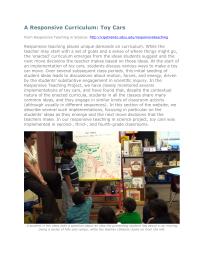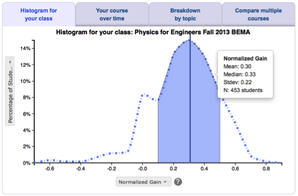
Developed by: Fred Goldberg, Sharon Bendall, Mike McKean, and Jennifer Radoff










middle schoolhigh schoolintro collegeinter-mediateupper levelgrad school other

calc based

alg based

conceptual









Overview
What? A practice of attending and responding to the substance of students' thinking. The instructor's next moves are based on students' emerging ideas, and informed by specific learning goals. Resources include launching questions and annotated videos of responsive teaching in elementary classrooms.
Why? Responsive teaching supports students in developing their own explanations and models that are grounded in cause and effect, evidence, and logical reasoning. At the same time that students learn science concepts, they also learn about the kinds of activities that constitute science.
Why not? Responsive teaching requires skill and training to implement effectively. Teachers must be prepared to respond creatively to unexpected ideas. This approach is not guaranteed to "cover" traditional science content.
Classroom video
Student skills developed
- Designing experiments
- Metacognition
Instructor effort required
- High
Resources required
- Simple lab equipment
Resources
Teaching Materials
You can find free examples of responsive curricula and instructions for enacting them from the Responsive Teaching in Science website.
Research
This is the third highest level of research validation, corresponding to:
- at least 1 of the "based on" categories
- at least 1 of the "demonstrated to improve" categories
- at least 1 of the "studied using" categories
Research Validation Summary
Based on Research Into:
- theories of how students learn
- student ideas about specific topics
Demonstrated to Improve:
- conceptual understanding
- problem-solving skills
- lab skills
- beliefs and attitudes
- attendance
- retention of students
- success of underrepresented groups
- performance in subsequent classes
Studied using:
- cycle of research and redevelopment
- student interviews
- classroom observations
- analysis of written work
- research at multiple institutions
- research by multiple groups
- peer-reviewed publication
References
- C. Alvarado, A. Daane, R. Scherr, and G. Zavala, Responsiveness Among Peers Leads to Productive Disciplinary Engagement, presented at the Physics Education Research Conference 2013, Portland, OR, 2013.
- J. Gouvea and L. Appleby, Expanding Research on Responsive Teaching, LSE 21 (2) (2024).
- D. Hammer, F. Goldberg, and S. Fargason, Responsive teaching and the beginnings of energy in a third grade classroom, Rev. Sci. Math. ICT Educ. 6 (1), 51 (2012).
- D. Hammer and E. van Zee, Seeing the Science in Children's Thinking: Case Studies of Student Inquiry and Physical Science. (Heinemann, Portsmouth, 2006).
- L. Jaber and D. Hammer, Engaging in Science: A Feeling for the Discipline, J. Learn. Sci. 25 (2), 156 (2015).
- J. Lineback, Mrs. Miller’s Evolution in Teaching Science as Inquiry, University of California, San Diego, 2012.
- J. Lineback, The Redirection: An Indicator of How Teachers Respond to Student Thinking, J. Learn. Sci. 24 (3), 419 (2014).
- J. Lineback and F. Goldberg, Using changes in framing to account for differences in a teacher’s classroom behavior, 2010.
- A. Maskiewicz and V. Winters, Interpreting Elementary Science Teacher Responsiveness Through Epistemological Framing, 2010.
- A. Maskiewicz and V. Winters, Understanding the Co-Construction of Inquiry Practices: A Case Study of a Responsive Teaching Environment, J. Res. Sci. Teaching 49 (4), 429 (2012).
- J. Radoff, F. Goldberg, D. Hammer, and S. Fargason, The Beginnings of Energy in Third Graders’ Reasoning, presented at the Physics Education Research Conference 2010, Portland, Oregon, 2010.
- J. Richards, The Role of Affect in Sustaining Teachers' Attention and Responsiveness to Student Thinking, presented at the Physics Education Research Conference 2013, Portland, OR, 2013.
- A. D. Robertson, R. Scherr, and D. Hammer (editors), Responsive Teaching in Science and Mathematics (Routledge, New York, 2015).
- A. D. Robertson, L. J. Atkins, D. M. Levin, and J. Richards, "What Is Responsive Teaching?," in Responsive Teaching in Science and Mathematics, edited by A. D. Robertson, R. Scherr, and D. Hammer (Routledge, New York, 2015).
- A. Robertson and L. Goodhew, Exploring the Role of Content Knowledge in Responsive Teaching, presented at the Physics Education Research Conference 2016, Sacramento, CA, 2016.
- I. Salter and L. Atkins Elliott, Student-Generated Scientific Inquiry for Elementary Education Undergraduates: Course Development, Outcomes and Implications, J. Sci. Teach. Educ. 24 (1), 157 (2013).
- T. Sikorski, Developing an Alternative Perspective on Coherence Seeking in Science Classrooms, PhD, University of Maryland, 2012.
- T. Sikorski and D. Hammer, A critique of how learning progressions research conceptualizes sophistication and progress, 2010.
- E. A. van Es and M. G. Sherin, Mathematics teachers’ “learning to notice” in the context of a video club, Teaching and Teacher Education 24 (2) 244-276 (2007).
- V. Winters and D. Hammer, Fourth Graders’ Framing of an Electric Circuits Task , presented at the Physics Education Research Conference 2009, Ann Arbor, Michigan, 2009.









